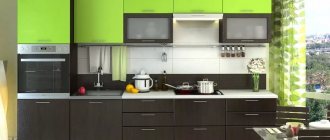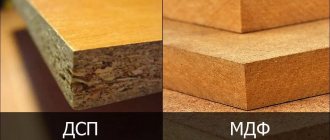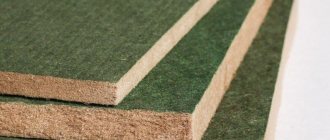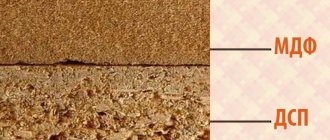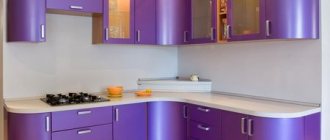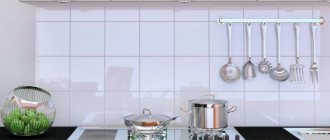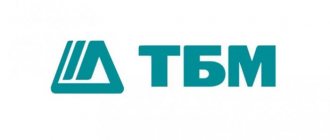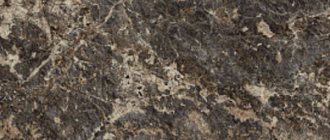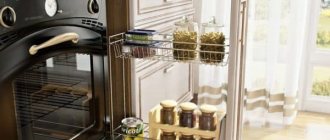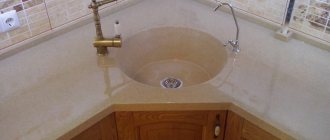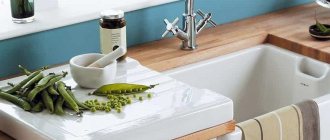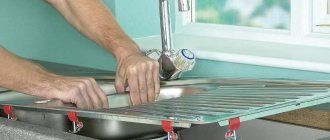What is better for the kitchen: MDF or laminated chipboard is a controversial issue. When arranging a kitchen, it is important to take into account a large number of nuances, one of which is the quality of the material for making furniture. Since not all people have the opportunity to purchase products made from natural solid wood, they have to look for a budget replacement.
The most popular materials are MDF and chipboard. At first glance they are similar, but in fact they differ in production technology and some properties. Today we will look at the positive and negative qualities of these panels.
MDF or chipboard for the kitchen: which is better?
Kitchen furniture: features
Quite often, well-known manufacturers prefer to use MDF and laminated chipboard when creating kitchen furniture. At the same time, serious requirements are placed on products installed in premises of this type - they must withstand temperature changes, high humidity and other negative influences. The materials we are considering are believed to have similar properties.
It is worth noting that most consumers consider the quality of furniture last. For many, appearance always comes first. Nevertheless, quality is a very important criterion, because the durability of the kitchen, aesthetics, and the general perception of the room depend on it.
Kitchen furniture must be reliable
In addition, kitchen furniture must remain in its original form, even despite frequent washing with chemicals and the negative effects of temperature and humidity. If the set does not meet these criteria, then in the first year the owners will be disappointed in the purchase, and the question will arise about renovating or buying a new kitchen. Of course, no one would want this, and therefore we recommend that you read this text carefully so as not to make a mistake with your choice.
How to choose quality furniture
- Carefully examine the coating - there should be no paint drips anywhere: their presence indicates the dubious quality of the furniture.
- You should not buy cabinets with plastic handles coated with “gold” or “silver”. Such fittings are unlikely to last long and will soon ruin their appearance. It is better to prefer metal chrome handles.
- A waterproof coating must be present on all surfaces - unprotected areas will sooner or later swell from moisture.
- Check all the joints and ends - the parts should fit snugly to the base, and the drawers should slide out freely.
What is MDF?
MDF was first invented in America back in the 60s of the last century, and in Russia this material appeared only in the late 90s. MDF boards are made from wood chips, ground into very small chips - it is practically split into fibers. Then these chips are thoroughly washed, excess dirt is removed, dried, and then pressed under high pressure.
As the fibers heat up, they begin to release a natural resin called lignin. It is this substance that glues the chips together, resulting in very strong slabs with a fine structure.
MDF board manufacturing process
The pressed slabs are then carefully sanded - this is done in order to remove any excess sagging from the surface. In addition, at this stage, panels of various thicknesses are formed. After which the surface of the slabs undergoes finishing treatment, which allows you to obtain a wide variety of materials for work.
Table 1. Types of MDF finishes
| Type | Description |
| Sanded | Sand only one side of the slab or two at once. Putty and various types of paint can be applied on top of such material. This is the simplest and most common type of MDF, allowing the buyer to decide on the finish of the slab. |
| Laminated | A special polymer film is applied to the surface of the plate. In this way, only one side or both are processed. The film has an aesthetic appearance that imitates the structure of various types of natural wood, which is why such boards have become especially popular among furniture makers. |
| Veneered | A thin layer of natural wood is glued on top of the slabs, so that the appearance of such material becomes similar to natural wood. Of course, due to such processing, MDF acquires a higher cost, but greater attractiveness and nobility. |
| Varnish coating | A thick layer of varnish is applied to the slab, making the material resistant to moisture. However, this is not the best option for the kitchen, because fingerprints will constantly appear on the surface. |
MDF kitchen set
The main advantages of MDF include the following:
- Safety for the health of residents, because in the process of its production no harmful chemical compounds or formaldehydes are used.
- It has good resistance to various mechanical damage.
- The furniture is easy to care for - this material has a smooth surface that does not absorb dirt.
- Resistance to high air humidity.
- This material is not affected by fungi.
- Easy to process even at home - MDF can be used to make structures of any shape.
- You can find a wide variety of colors of MDF boards on sale, which allows each person to choose the best option for themselves.
There are a large number of MDF colors.
There are also some disadvantages of this material:
- The obvious disadvantage is the rather high cost of the material, but it is still lower than that of natural wood.
- Some note that when exposed to too much heat, MDF can separate into layers, so it should be protected from such negative effects.
- Furniture does not react well to aggressive alkali.
- Untreated surfaces have poor resistance to moisture. Thus, the material absorbs water, which is why it begins to swell after some time.
- Scratches appear quickly on glossy surfaces, so it is not recommended to use metal brushes for cleaning. A problem that has already appeared can only be corrected by painting, and the entire surface will have to be painted.
- Due to constant fumes in the kitchen, the varnished countertop becomes faded and matte.
- After some time, the material will still lose its original strength, which can cause cabinet fittings to become loose.
Video - Veneer facades for the kitchen
Advantages of MDF over laminated chipboard
So, after comparing two types of wood-based boards, we can come to the conclusion that, in general, MDF differs from chipboard for the better. The advantages of MDF are as follows:
- no chips are formed on the edges, in places where screws are tightened;
- is characterized by high density and strength;
- the material is environmentally friendly;
- more resistant to moisture than laminated chipboard;
- MDF can be bent, milled, and therefore create beautiful shapes and designs.
The advantages affect the price. Typically, the cost of fibreboards is higher than that of particle boards. If MDF is combined with metal, glass, made in accordance with the original design solution, and decorated, then its price increases even more. At the same time, such furniture, whether it is in the kitchen or in the bedroom, requires more careful care.
What is chipboard?
The first chipboards went on sale back in the 18th century. Of course, they were not of high quality, but in subsequent years this material was significantly improved. This type of particle board has several manufacturing stages:
Step one: processing of natural wood and procurement of raw materials. Laminated chipboard is made from large sawdust, and then the workpiece is ground to obtain a finer fraction.
First of all, sawdust is prepared
Step two: drying the sawdust. The resulting small chips are sent to special equipment, where they are dried under the influence of air.
Drying raw materials
Step three: the raw materials go through the selection stage. Thus, only small chips go into production, and large pieces of wood are crushed again.
Sorting of raw materials
Step four: mixing with additional component. At this stage, synthetic formaldehyde resin is added to the shavings for better bonding.
Formaldehyde resin
Step five: forming the workpiece. The mixture of resin and chips enters the conveyor, where rough slabs are formed in several layers using cold pressing.
This is what the slab blanks look like
Step six: the surface of these plates is carefully sanded. In order to give the material a decorative appearance (as in the case of MDF), a special polymer film is applied to the surface.
Film application process
Next, all that remains is to cut the slabs into standard sizes. After which they are sent for sale.
The following advantages of laminated chipboard are highlighted:
- Budget cost compared to natural solid wood and even MDF.
- Good resistance to temperature changes and high humidity.
- Large selection of different colors. As with MDF, chipboard has a huge variety of laminated surfaces.
- The material does not deform as a result of mechanical damage.
- While ordinary chipboard quickly deteriorates, laminated boards are durable.
- The material has good scratch resistance. In addition, it can be cleaned with various chemicals.
Laminated chipboards are sold in various shades.
Among the disadvantages of the material, the following can be noted:
- The boards are quite rigid compared to MDF, which means they are less easy to process. It turns out that it is difficult to make shaped structures from such material.
- This material often chips at the edges during cutting, so it is best not to cut it with a regular handsaw.
- The composition contains dangerous formaldehydes - this is the point that can negate any positive qualities of laminated chipboard.
When sawing, chips often occur.
Despite such significant shortcomings, not everything is so bad. After all, there are two types of laminated chipboard: marked E1 and E2. In the first case, 10 grams of toxic resin are added per hundred grams of shavings; in the second case, the amount of formaldehyde for the same mass of sawdust exceeds 30 grams.
Therefore, if you have already decided to use laminated chipboard to make furniture, then you should only choose the option marked E1, because it is relatively safe.
Production
To produce both materials, wood production waste is used: knots, branches, crooked trunks, trimmings.
All these materials turn into small chips, which subsequently become the base of MDF or chipboard.
And here lies the first difference between these two materials: For laminated chipboard, the chips are made quite large; for MDF, the blanks are crushed to the smallest possible size.
The second difference is related to the process of combining sawdust and shavings into a single mass:
- For more modern material, the hot pressing method is used;
- For the manufacture of chipboards, formaldehyde resins are used, which are not particularly safe.
At the same time, MDF already has a smooth and soft structure, completely ready for furniture production; laminated chipboard requires additional sanding.
Which material is suitable for kitchen furniture: comparison
To understand whether it is better to buy furniture made from laminated chipboard or MDF for the kitchen, you need to compare their positive and negative qualities.
Durability
Of course, when purchasing various pieces of furniture for the kitchen, we plan to use them for many years in a row, so it is necessary to choose the most durable material. As we mentioned above, low-quality furniture will quickly become unusable, and the kitchen will have to be replaced every two or three years, which is completely unprofitable.
MDF has better wear resistance
Furniture made from MDF is characterized by the highest durability (this feature is due to the almost natural composition of this material), and structures made from laminated chipboard will quickly lose their original appearance. If you provide good care for MDF furniture, it will definitely serve you for many years.
Resistance to various damages and negative impacts
Kitchen furniture must be resistant to various impacts and other damage. Of course, products made from MDF have better resistance to wear and oil stains. However, such a surface will suffer from constant exposure to steam or any liquid, and this will become noticeable within a few years. Furniture made from chipboard is less likely to deform under such conditions.
Laminated chipboard is stronger due to the synthetic resin in its composition
Otherwise, I would like to note that furniture deteriorates and breaks with equal frequency due to various mechanical damages, so it is difficult to select the best of the two materials. Note that laminated chipboard has a higher resistance to scratches, moreover, these surfaces can be washed without fear even with strong chemicals.
Environmental Safety
The content of toxic components in the composition negatively affects human health, so this point cannot be ignored. And since laminated chipboard still contains formaldehyde, albeit in small quantities (E1), purchasing such furniture is a risk, especially if kitchen furniture is made from it. Therefore, despite the large number of positive qualities, many refuse this lumber.
Chipboards may have a specific odor due to formaldehyde
Note! We should take a short digression to understand how synthetic resin affects health. This poison affects the nervous system, respiratory organs, liver, and kidneys. In addition, the substance irritates the mucous membranes of the eyes and provokes an allergic reaction.
The use of MDF in the kitchen, in turn, does not in any way affect people’s well-being, so if we evaluate materials on this point, then MDF is clearly the leader.
Aesthetic features
The attractive appearance of a kitchen is sometimes the main criterion by which it is chosen. Here, the two materials we are considering do not have any particular advantages over each other, since the modern furniture industry offers a lot of kitchen models made from both MDF and laminated chipboard. The choice is always a matter of taste, so for each buyer the conclusion about the external attractiveness of such furniture will be individual.
An example of an aesthetic kitchen made from chipboard
But, if you want to purchase a kitchen with various shaped elements, then of course you should choose MDF - laminated chipboard, due to its greater rigidity, is not suitable for the manufacture of such furniture elements. I would also like to note that laminated chipboard has a wide variety of shades, and if you are looking for furniture in bright or unusual colors, then you should take a closer look at this material.
Choice for the bedroom
For such a room it remains a very important accessory. For this reason, choosing the material from which it will be made is a very important process.
Today, very often people order bedroom furniture from chipboard or MDF, but still do not understand which is better. First, let's look at chipboard. The presented product is obtained from shavings, which are then treated with a binding component, namely formaldehyde resins.
DPS today are very relevant in the manufacture of cabinet furniture, or rather bedroom sets. The main advantages of chipboard material can be considered: easy processing, strength, excellent water resistance, the material perfectly and firmly holds all fasteners and is not expensive.
You can see what a kitchen countertop made of chipboard looks like in this article.
Chipboard is very often used in the production of economy class furniture. In this case, furniture sets are often installed in offices. However, for those who do not have a lot of money, they can also try installing a chipboard product in their bedroom.
However, the presented material has one significant drawback: when formaldehyde resins evaporate, a negative effect on human health occurs. In addition, there is a specific type of chipboard that is prohibited for use in the manufacture of bedroom furniture.
You can find out what the thickness of laminated chipboard is from this article.
Now you can move on to MDF. The presented product is characterized by a slab, the production process of which takes place from sawdust. Their fastening is carried out using paraffin and lignin. Compared to chipboard, this material is environmentally friendly, therefore it is very widely used in the manufacture of bedroom furniture.
The main advantages of MDF can be considered:
- environmental friendliness;
- minimal thickness, making it easy to process;
- has all the benefits of wood.
How do the plates differ in appearance?
You can notice the differences between laminated materials only by their edges. Thus, MDF has a smaller and denser structure, while laminated chipboard has rough shavings visible on the cut. On the surface of chipboard without any treatment, you can notice the presence of large wood fibers.
In addition, if you cut two boards of the same shape and thickness, you will notice that the MDF will be a little lighter.
Lumber cutting
If pieces of furniture have carved parts, then we can say with confidence that this is MDF. Even a professional will not be able to cut out such elements from a material such as chipboard, because it will simply crumble during the work.
How is MDF made? How to define quality?
To produce MDF, wood is crushed, dried and pressed.
Lignite, a natural substance found in wood, binds wood particles together instead of resins. There are practically no formaldehydes in MDF, and in terms of chemical safety the material is as close as possible to natural wood. For protection, PVC film, veneer or enamel is applied to it. The photo below shows the EGGER chipboard we use in production:
Is it possible to combine materials?
Often, in order to reduce the cost of products, manufacturers combine different materials. Basically, MDF is used to make cabinet doors, while chipboard is best suited for the frame. Nowadays, it is almost impossible to find such cabinets, the frame of which consists of finely divided material - the fact is that such structures will be too expensive.
Materials do not exclude the option of combining
Bathroom furniture options
Headsets with floor mounting option
They are chests of drawers with several drawers in which a sink is mounted.
They allow you to rationally use the space under the sink and hide the sometimes unsightly background. The set includes a mirror, and sometimes additional side cabinets. This option is great for small bathrooms where no other furnishings fit. Drawers allow you to hide household chemicals, hygiene items and other items from view.
Hanging kits
Wall-mounted furniture is mainly preferred by those buyers who want to make the bathroom look more modern. In addition, this option greatly facilitates the cleaning process, since there is no need to “go around” numerous objects. Such furniture goes well with hanging plumbing fixtures, forming a single ensemble.
Corner sets
Sometimes corner bathroom furniture is the best solution for a small room, allowing you to use all areas of the space.
Small bathrooms often use corner vanities with a sink, thereby increasing the area in the center of the room. In this case, an elegant solution can be used when the mirror above the sink is a cabinet door.
Most often, a ready-made set of bathroom furniture consists of a floor or hanging cabinet, a cabinet with a sink, small cabinets and a shelf with a mirror. However, there are also mini-options - for example, a cabinet and a mirror.
The choice of material depending on the kitchen design
Depending on the design of the overall kitchen interior, various lumber is used. Of course, the visual differences between laminated chipboard and MDF are small, but designers have the following opinion regarding the style of the kitchen and the materials for it:
- Classical. In this case, it is better to give preference to untreated MDF boards, since they can be painted independently and given an unusual appearance using the patina technique.
- Art Deco. Since the quality of the glossy surface of laminated chipboard is slightly better, it is recommended to use this material. However, MDF is also perfect for such an interior.
- High tech. Since this style does not have various figured facades, it is quite possible to use laminated chipboard.
- Provence. As in the case of the classic style, finely dispersed material for painting is most suitable.
MDF kitchen in classic style
What else should you pay attention to?
Legs
Look at the legs. The larger the area of each leg, the stronger the entire product. The number of legs also matters. There are at least four, but some larger models may have additional center supports.
Accessories
Accessories. Bolts and fasteners should not stick out, have sharp edges or, conversely, noticeable play. The most reliable companies are AMIG (Spain), Blum (Austria), GTV (Poland), Hettich International (Germany), Russian manufacturers Boyard and Valmax.
General requirements for the use of furniture
Despite the fact that manufacturers promise that kitchens are resistant to high temperatures, you should not expose furniture made from MDF or laminated chipboard to temperatures exceeding 75 degrees. Due to this impact, the surface may be deformed, so it is not recommended to place heating devices on the countertop.
If the kitchen set is constantly exposed to sunlight, then after a few months it may become pale (this is especially true for furniture made of laminated chipboard). You should not allow the slabs to be regularly soaked in water - in such conditions, even the most durable material will rapidly swell.
You will need to keep surfaces clean
The following surface care rules must be followed:
- It is advisable to regularly wipe the furniture with a dry cloth to remove dust; in addition, you can purchase a special product for delicate cleaning;
- if water gets on the surface, it should be removed as quickly as possible with a well-absorbing cloth;
- You should not use wax for such materials, which is used to polish natural wood - it will not be absorbed and will remain in a greasy layer.
MDF and laminated chipboard react poorly to wax intended for solid wood. If this rule is neglected, the laminated surface may become stained and even deformed. When cleaning, you should not use various products with a high acid content.
MDF kitchen combined with living room
Since both materials are resistant to fungi, furniture can stand in dry rooms for many years, and no additional treatment is required in this case.
If you don’t know what to put and where, how to place a set with everything you need in a small kitchen, we advise you to carefully study the special article and then apply the knowledge gained from it in practice.
Characteristics of wood boards
To select the optimal material, it is necessary to take into account its properties.
Fiberboard
These products are widely used for making furniture parts. The decoding of the abbreviation - fibreboard - indicates the composition of the product. Basic material parameters:
- Moisture resistance. This is a significant advantage. The panels can withstand severe changes in humidity, but if the impact is strong or constant, deformation and warping will occur.
- Durability. The service life is tens of years if used correctly.
- Safety. The products comply with all standards, so they can be used for any room in the house.
- Easy to install. Cutting is carried out with ordinary tools.
- Resistance to mechanical stress. This is explained by the high density of the slabs - from 750 to 1100 kg/m3.
For the production of interior items, a solid type of fiberboard with a treated coating (hardboard) is selected. This option is used for the manufacture of parts up to 6 mm thick: back walls, drawer bottoms, decorative inserts for open areas and frame fronts.
In furniture production, fibreboards are usually used in fragments, for example, perforated inserts are used for facades, and untreated fibreboards are used for back walls
MDF
Stands for "medium density fibreboard". Although the product is usually classified as a separate category, it is a type of fiberboard that is produced using the “dry” method. The material is often compared to laminated chipboard. Both options are quite popular and in demand, but MDF has distinctive properties:
- Environmental friendliness. Although the panels contain binders that may be harmful to humans, their quantities are minimal. In addition, the slabs undergo a complete decorative finishing, which eliminates any fumes.
- Possibility of processing. Due to the dense structure, parts can be cut, milled and figured without fear of damage. In this parameter, MDF differs from other products.
- Variety of decorative coatings. The surface of the slabs can be finished with PVC film, acrylic, plastic and enamel to give the desired visual effect.
- Resistance to humidity. According to this indicator, the material is inferior to the previous variety, but superior to chipboard.
- High price. This is a significant disadvantage of the product. The product is expensive not only due to its good qualities due to production technology, but also due to processing.
In the world of MDF furniture, facades with 3D textures are considered the latest fashion, but such milling can only be performed on high-tech equipment.
Like any boards for which wood is used, MDF is a fire hazardous material, but for it to ignite, the temperature must be quite high.
In the production of furniture, products with a thickness of 8 to 18 mm are used. Most often, the panels are used to create the facades of chests of drawers, cabinets, kitchen units; as a result of complex technology, it is also possible to obtain radius elements. The product is well suited for making shaped overlays and shelves for shoe racks.
Chipboard and laminated chipboard
This abbreviation stands for "chipboard". Its main difference from previous varieties is that the parts consist of a larger fraction. Although the products are widely distributed in the furniture market, they cause a lot of controversy. The fact is that chipboard contains formaldehyde resins, the harmfulness of which is undeniable. But when determining environmental friendliness, they take into account that processed slabs with safety class E1 or E0.5 are used for the production of interior items. The most popular option is with a laminated coating. Due to the cladding, the level of toxic fumes is reduced to a minimum.
According to domestic experts, the laminated coating of furniture boards blocks harmful formaldehyde fumes
Also, laminated chipboard has the following features:
- High strength. The outer decorative layer has good wear resistance, the elements can withstand heavy loads. The density of the panel has a great influence: low-quality sheets are porous and fragile.
- The need for special processing. Although pruning is not difficult and can be done with improvised tools, for a high-quality result you will need a special machine that performs the top cut and bottom trim. This is necessary to prevent chipping of the lamination.
- Availability. The cost of the product depends on the thickness, cladding and strength, but it is significantly less than MDF.
- Decorative. A significant advantage of the material is a wide range of colors and imitation of tree textures. This allows you to create visually attractive interior solutions.
- Low moisture resistance. Due to their porosity, the panels quickly absorb water, so for areas that will be constantly exposed to moisture, panels with special protective impregnation are selected. The influence of humidity can also be minimized by using standard slabs: to do this, their edges are closed, and the front layer should not be damaged.
In damp rooms, damage to the laminating layer leads to delamination and complete destruction of the material within a year.
Chipboard is a universal product that is suitable for the manufacture of almost any furniture.
Let's sum it up
So, we have assessed all the main advantages and disadvantages of MDF and laminated chipboard. We can conclude that MDF boards are more environmentally friendly, and if your financial capabilities allow, then do not skimp on purchasing such furniture.
If you only have a limited budget for furnishing your kitchen, then it is advisable to buy furniture made from chipboard. However, you should avoid purchasing hazardous material marked E2 - it is absolutely not suitable for making kitchen furniture.
Which board is more resistant to moisture: chipboard or MDF?
In its pure form, the chipboard slab does not tolerate moisture very well - when wet, its base actively begins to absorb water and can increase its volume by about 30%. Laminate chipboard has slightly better moisture resistance - laminate itself is not afraid of water and can resist getting wet for quite a long time, which is why it is often used to create budget-class countertops.
It has proven itself to be excellent, but if the outer coating is damaged, all the shortcomings are fully revealed - if water seeps into the slab, it will be actively absorbed.
Chipboard that has been wet.
Since MDF itself is a denser material, even without an external coating it resists getting wet well and, even if it gets into water, it can hold its shape for several hours, which is superior even to some types of natural wood.
Fastener retention
Chipboard has long gained the reputation of a “disposable” material - furniture assembled from it is very difficult to disassemble without loss, transport to another place and reassemble. This is due to the fastenings, which, even if the screws are screwed in and out perfectly evenly during reassembly, at best will hold much weaker. The worst is also the more likely outcome - the attachment point will simply crumble and you will have to additionally treat it with glue or use screws of larger diameter.
As a result, if you have a choice, then you should take furniture made of chipboard, in which not screws are used as fasteners, but bolted connections with wide washers. If they break, then you won’t have to worry about the possibility of restoring the fasteners.
MDF, due to its density, easily tolerates repeated assembly and disassembly - in this, again, it is not very different from natural wood.
Possibilities for decorating chipboard and MDF
In the case of particle boards and fibreboards, decoration means finishing these materials with additional layers of laminate or veneer. If in the second case there are usually no problems, then when decorating with laminate or paper with chipboard there may be difficulties. They are caused by the initially rough surface of the slab - if a thin film is glued to it, then all the tubercles and veins will be visible on it. As a result, all chipboard slabs are sanded and only after that can film or paper with a pattern be applied to them.
MDF sheets are initially devoid of such disadvantages due to their density - immediately after production they are suitable for applying any decorative coating.
